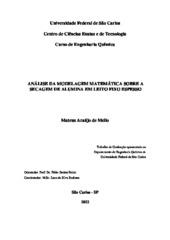| dc.contributor.author | Mello, Mateus Araújo de | |
| dc.date.accessioned | 2022-04-27T13:47:22Z | |
| dc.date.available | 2022-04-27T13:47:22Z | |
| dc.date.issued | 2022-04-11 | |
| dc.identifier.citation | MELLO, Mateus Araújo de. Análise da modelagem matemática sobre a secagem de alumina em leito fixo espesso. 2022. Trabalho de Conclusão de Curso (Graduação em Engenharia Química) – Universidade Federal de São Carlos, São Carlos, 2022. Disponível em: https://repositorio.ufscar.br/handle/ufscar/15944. | * |
| dc.identifier.uri | https://repositorio.ufscar.br/handle/ufscar/15944 | |
| dc.description.abstract | The fixed bed is widely applied, studied and reported in the literature. From the stuffing towers found in the chemical industry to the modern fixed beds with membranes used in the production of hydrogen, many were the contributions to reach the state of the art of this type of reactor. Fixed bed drying, in which the bed of particles remains stationary while the air percolates through the porous medium, yielding heat and absorbing moisture, is more used when dealing with impact-sensitive grains, even so, on a small scale. However, knowledge about fixed bed drying processes can be extended to conveyor belt dryers, in addition to storage silos, with regard to dynamic behavior. Unlike drying with bed movement, fixed bed drying accentuates the temperature and humidity gradients of the particles, and this non-uniformity is a generally undesired effect. The Final Paper proposal summarized here aims to simulate a dynamic model of alumina drying in a fixed bed, varying both typical operating conditions and bed dimensions. Numerical tests will then be carried out using a MatLab program developed in the Particulate Systems area of DEQ/UFSCar. With the results of the simulations it is intended to identify trends of change in the magnitude of the internal gradients in face of the variations made in the program. | eng |
| dc.description.sponsorship | Não recebi financiamento | por |
| dc.language.iso | por | por |
| dc.publisher | Universidade Federal de São Carlos | por |
| dc.rights | Attribution-NonCommercial-NoDerivs 3.0 Brazil | * |
| dc.rights.uri | http://creativecommons.org/licenses/by-nc-nd/3.0/br/ | * |
| dc.subject | Secagem | por |
| dc.subject | Leito fixo | por |
| dc.subject | Drying | eng |
| dc.subject | Fixed bed | eng |
| dc.title | Análise da modelagem matemática sobre a secagem de alumina em leito fixo espesso | por |
| dc.title.alternative | Analysis of mathematical modeling on the drying of alumina in a thick fixed bed | eng |
| dc.type | TCC | por |
| dc.contributor.advisor1 | Freire, Fábio Bentes | |
| dc.contributor.advisor1Lattes | http://lattes.cnpq.br/8937961078558996 | por |
| dc.contributor.advisor-co1 | Barbosa, Luan da Silva | |
| dc.contributor.advisor-co1Lattes | http://lattes.cnpq.br/7228332759151003 | por |
| dc.description.resumo | O leito fixo é amplamente aplicado, estudado e reportado na literatura. Desde as torres de recheio encontradas na indústria química até os modernos leitos fixos com membranas usados na produção de hidrogênio, muitas foram as contribuições para que o estado da arte desse tipo de reator fosse alcançado. A secagem em leito fixo, em que o leito de partículas permanece imovel enquanto o ar percola o meio poroso cedendo calor e absorvendo umidade, é mais utilizada quando se trata de grãos com sensibilidade ao impacto, mesmo assim, em pequena escala. Pode-se, entretanto, estender o conhecimento sobre processos de secagem em leito fixo para os secadores do tipo esteira rolante, além dos silos de armazenamento, no que diz respeito ao comportamento dinâmico. Diferentemente da secagem com movimentação do leito, a de leito fixo acentua os gradientes de temperatura e de umidade das partículas, sendo que essa não uniformidade é um efeito geralmente indesejado. A proposta de TG aqui resumida tem por objetivo fazer simulações de um modelo dinâmico da secagem de alumina em leito fixo, variando tanto as condições operacionais típicas quanto as dimensões do leito. Serão feitos, então, ensaios numéricos usando um programa em MatLab desenvolvido na área de Sistemas Particulados do DEQ/UFSCar. Com os resultados das simulações pretende-se identificar tendências de mudança na magnitude dos gradientes internos frente às variações feitas no programa. | por |
| dc.publisher.initials | UFSCar | por |
| dc.subject.cnpq | ENGENHARIAS::ENGENHARIA QUIMICA | por |
| dc.publisher.address | Câmpus São Carlos | por |
| dc.publisher.course | Engenharia Química - EQ | por |

